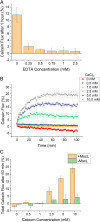Building a synthetic mechanosensitive signaling pathway in compartmentalized artificial cells
- PMID: 31371493
- PMCID: PMC6708380
- DOI: 10.1073/pnas.1903500116
Building a synthetic mechanosensitive signaling pathway in compartmentalized artificial cells
Abstract
To date, reconstitution of one of the fundamental methods of cell communication, the signaling pathway, has been unaddressed in the bottom-up construction of artificial cells (ACs). Such developments are needed to increase the functionality and biomimicry of ACs, accelerating their translation and application in biotechnology. Here, we report the construction of a de novo synthetic signaling pathway in microscale nested vesicles. Vesicle-cell models respond to external calcium signals through activation of an intracellular interaction between phospholipase A2 and a mechanosensitive channel present in the internal membranes, triggering content mixing between compartments and controlling cell fluorescence. Emulsion-based approaches to AC construction are therefore shown to be ideal for the quick design and testing of new signaling networks and can readily include synthetic molecules difficult to introduce to biological cells. This work represents a foundation for the engineering of multicompartment-spanning designer pathways that can be utilized to control downstream events inside an AC, leading to the assembly of micromachines capable of sensing and responding to changes in their local environment.
Keywords: MscL; artificial cells; nested vesicle; phospholipase A2; signaling pathway.
Conflict of interest statement
The authors declare no conflict of interest.
Figures



Similar articles
-
Cell-sized mechanosensitive and biosensing compartment programmed with DNA.Chem Commun (Camb). 2017 Jun 29;53(53):7349-7352. doi: 10.1039/c7cc03455e. Chem Commun (Camb). 2017. PMID: 28524182 Free PMC article.
-
Engineering de novo membrane-mediated protein-protein communication networks.J Am Chem Soc. 2012 Apr 4;134(13):5746-9. doi: 10.1021/ja300523q. Epub 2012 Mar 26. J Am Chem Soc. 2012. PMID: 22428921
-
Development of mechanosensitive synthetic cells for biomedical applications.SLAS Technol. 2024 Apr;29(2):100095. doi: 10.1016/j.slast.2023.06.004. Epub 2023 Jun 28. SLAS Technol. 2024. PMID: 37385542
-
Ion-channels: goals for function-oriented synthesis.Acc Chem Res. 2013 Dec 17;46(12):2773-80. doi: 10.1021/ar400007w. Epub 2013 May 7. Acc Chem Res. 2013. PMID: 23651489 Review.
-
Artificial Cells: Synthetic Compartments with Life-like Functionality and Adaptivity.Acc Chem Res. 2017 Apr 18;50(4):769-777. doi: 10.1021/acs.accounts.6b00512. Epub 2017 Jan 17. Acc Chem Res. 2017. PMID: 28094501 Free PMC article. Review.
Cited by
-
Engineering motile aqueous phase-separated droplets via liposome stabilisation.Nat Commun. 2021 Mar 15;12(1):1673. doi: 10.1038/s41467-021-21832-x. Nat Commun. 2021. PMID: 33723263 Free PMC article.
-
Artificial receptor-mediated phototransduction toward protocellular subcompartmentalization and signaling-encoded logic gates.Sci Adv. 2023 Mar;9(9):eade5853. doi: 10.1126/sciadv.ade5853. Epub 2023 Mar 1. Sci Adv. 2023. PMID: 36857444 Free PMC article.
-
Cell-sized asymmetric phospholipid-amphiphilic protein vesicles with growth, fission, and molecule transportation.iScience. 2023 Jan 31;26(3):106086. doi: 10.1016/j.isci.2023.106086. eCollection 2023 Mar 17. iScience. 2023. PMID: 36843838 Free PMC article.
-
Surfactant-free production of biomimetic giant unilamellar vesicles using PDMS-based microfluidics.Commun Chem. 2021 Jun 29;4(1):100. doi: 10.1038/s42004-021-00530-1. Commun Chem. 2021. PMID: 36697530 Free PMC article.
-
Intercellular communication between artificial cells by allosteric amplification of a molecular signal.Nat Commun. 2020 Apr 3;11(1):1652. doi: 10.1038/s41467-020-15482-8. Nat Commun. 2020. PMID: 32246068 Free PMC article.
References
-
- Lai E. C., Notch signaling: Control of cell communication and cell fate. Development 131, 965–973 (2004). - PubMed
-
- Waters C. M., Bassler B. L., Quorum sensing: Cell-to-cell communication in bacteria. Annu. Rev. Cell Dev. Biol. 21, 319–346 (2005). - PubMed
-
- Ratajczak J., Wysoczynski M., Hayek F., Janowska-Wieczorek A., Ratajczak M. Z., Membrane-derived microvesicles: Important and underappreciated mediators of cell-to-cell communication. Leukemia 20, 1487–1495 (2006). - PubMed
-
- Rasmussen H., Cell communication, calcium ion, and cyclic adenosine monophosphate. Science 170, 404–412 (1970). - PubMed
-
- Clapham D. E., Calcium signaling. Cell 131, 1047–1058 (2007). - PubMed
Publication types
MeSH terms
Substances
LinkOut - more resources
Full Text Sources

